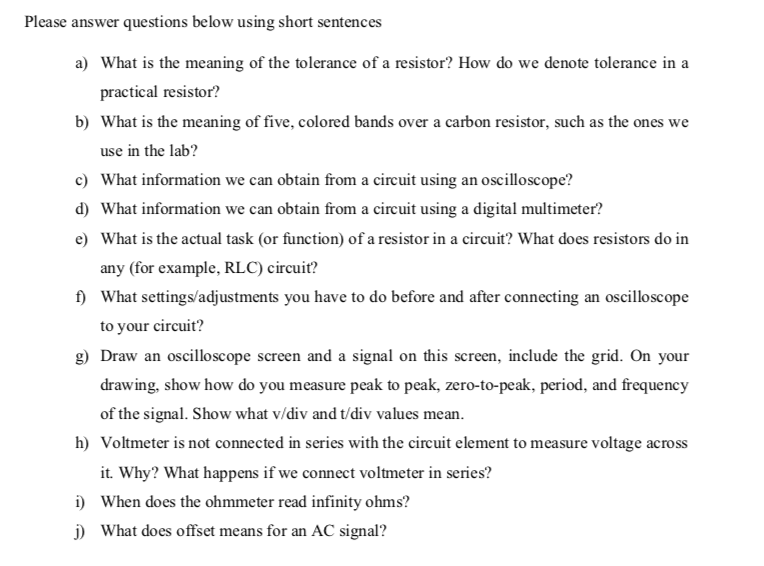Please answer questions below using short sentences a) What is the meaning of the tolerance of a resistor? How do we denote tolerance in a practical resistor? b) What is the meaning of five, colored bands over a carbon resistor, such as the ones we use in the lab? c) What information we can obtain from a circuit using an oscilloscope? d) What information we can obtain from a cireuit using a digital multimeter? e) What is the actual task (or function) of a resistor in a circuit? What does resistors do in any (for example, RLC) circuit? ) What settings/adjustments you have to do before and after connecting an oscilloscope to your circuit? g) Draw an oscilloscope screen and a signal on this screen, include the grid. On your drawing, show how do you measure peak to peak, zero-to-peak, period, and frequency of the signal. Show what v/div and t/div values mean. h) Voltmeter is not connected in series with the circuit element to measure voltage across it. Why? What happens if we connect voltmeter in series? i) When does the ohmmeter read infinity ohms? j) What does offset means for an AC signal?
Please answer questions below using short sentences a) What is the meaning of the tolerance of a resistor? How do we denote tolerance in a practical resistor? b) What is the meaning of five, colored bands over a carbon resistor, such as the ones we use in the lab? c) What information we can obtain from a circuit using an oscilloscope? d) What information we can obtain from a cireuit using a digital multimeter? e) What is the actual task (or function) of a resistor in a circuit? What does resistors do in any (for example, RLC) circuit? ) What settings/adjustments you have to do before and after connecting an oscilloscope to your circuit? g) Draw an oscilloscope screen and a signal on this screen, include the grid. On your drawing, show how do you measure peak to peak, zero-to-peak, period, and frequency of the signal. Show what v/div and t/div values mean. h) Voltmeter is not connected in series with the circuit element to measure voltage across it. Why? What happens if we connect voltmeter in series? i) When does the ohmmeter read infinity ohms? j) What does offset means for an AC signal?
Delmar's Standard Textbook Of Electricity
7th Edition
ISBN:9781337900348
Author:Stephen L. Herman
Publisher:Stephen L. Herman
Chapter29: Dc Generators
Section: Chapter Questions
Problem 16RQ: Explain the difference between cumulative- and differential-compounded connections.
Related questions
Question

Transcribed Image Text:Please answer questions below using short sentences
a) What is the meaning of the tolerance of a resistor? How do we denote tolerance in a
practical resistor?
b) What is the meaning of five, colored bands over a carbon resistor, such as the ones we
use in the lab?
c) What information we can obtain from a circuit using an oscilloscope?
d) What information we can obtain from a circuit using a digital multimeter?
e) What is the actual task (or function) of a resistor in a circuit? What does resistors do in
any (for example, RLC) circuit?
) What settings/adjustments you have to do before and after connecting an oscilloscope
to your circuit?
g) Draw an oscilloscope screen and a signal on this screen, include the grid. On your
drawing, show how do you measure peak to peak, zero-to-peak, period, and frequency
of the signal. Show what v/div and t/div values mean.
h) Voltmeter is not connected in series with the circuit element to measure voltage across
it. Why? What happens if we connect voltmeter in series?
i) When does the ohmmeter read infinity ohms?
j) What does offset means for an AC signal?
Expert Solution
This question has been solved!
Explore an expertly crafted, step-by-step solution for a thorough understanding of key concepts.
Step by step
Solved in 4 steps with 3 images

Knowledge Booster
Learn more about
Need a deep-dive on the concept behind this application? Look no further. Learn more about this topic, electrical-engineering and related others by exploring similar questions and additional content below.Recommended textbooks for you

Delmar's Standard Textbook Of Electricity
Electrical Engineering
ISBN:
9781337900348
Author:
Stephen L. Herman
Publisher:
Cengage Learning

Delmar's Standard Textbook Of Electricity
Electrical Engineering
ISBN:
9781337900348
Author:
Stephen L. Herman
Publisher:
Cengage Learning